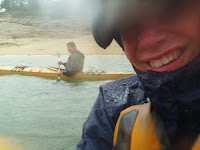Current Adventures Kayaking School & Trips' Dan Crandall leans in holding a rescue throw bag and tells them this about a group of paddlers at the access before getting on the river.
In his story, the more experienced paddler asks everyone if they have a throw bag?
 |
| Courtesy of the River Store |
The veteran paddler quickly offers him his saying, "You'll need to be ready in case I need rescuing, but however," the veteran paddler warned, "If it's the other way around you just might be out of luck."
The story got a laugh, but Crandall's point should be well taken. You should be prepared for any situation when whitewater kayaking. The life you save just might be your own.
El Dorado County SAR Swift Water training officer Tim Cannavaro says it's appropriate to bring basic safety gear on every outing down the river. All your equipment should be in excellent condition to avoid untimely failure and additional items may certainly be relevant or necessary depending on the individual's responsibilities and abilities.
"Accidents happen," said Cannavaro, "Even on easier local runs. Maybe not to your group, but someone else may be unprepared."
Current Adventures and The River Store recommends this safety gear checklist before getting on the river.
- Proper river running kayak with "high" volume and enough length to provide for ascending moves and quick response/hull speed in fast or high water situations. Good "grab handles for swimmers to access. Good Inner floatation. (Float bags or similar.)
- Personal equipment:
- "Rescue" style PFD with quick release tow tether, good flotation. (Less than 3-years-old or newer depending on previous use and UV exposure.)
- Dress to be "Wet" in case of a sustained "In-Water" rescue attempt.
- Float bags.
- Breakdown paddle in the boat.
- High pitch waterproof whistle. (Such as Fox 40 Classic Safety Whistle.)
- Rescue throw bag & rope. (70' Spectra recommended.)
- Waist belt. (tubular webbing)
- Four carabiners. (At least one locking)
- "Rescue" knife with secure but easy access sheath of pocket storage.
- Good footwear for shoreline activity, to be worn at all times both in and out of the boat. (Open-toed sandals are NOT a good option in most cases.)
- Two or more prusik loops.
- Cell phone in a waterproof case.
- Small waterproof flashlight w/ Lithium battery and spare battery.
- Egress Map with personal/local phone numbers. (Family, friends, CHP, Heli, 911, Shuttle Service, and area outfitters. Even without cell service, a text may go through.)
- Well-stocked First Aid kit.
- Including, face shield or similar CPR aid, bandages, sling, rescue "blanket" SAM splint, aspirin, glucose, cloth tape, shears, first aid "book" or cards. pencil and waterproof paper, Tincture of Benzoin, gauze pads, waterproof tape.
While all boaters should have proper skills and paddling abilities for the water they are paddling in, Cannavaro reminds us, that you should also bring along a healthy respect for any river that you're going to kayak to despite any familiarity with it.
"Especially on sections often paddled or local." said Cannavaro, "Comfort leads to complacency."
By being well prepared with these tools and knowledge to help in any rescue situation you encounter, Cannavaro says, it will make you a well-rounded member of your paddling team.
If you want more information about their recommended gear list contact The River Store at info@TheRiverStore.com

















